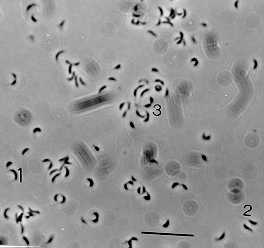Researchers have discovered marine bacteria, which adhere to various surfaces with the help of a biological glue that is several times stronger than the commercial glues available today. Now, it is hoped that it will be possible to use this glue for industrial purposes
Dr. Dror Bar-Nir, Galileo

The water-dwelling bacterium Caulobacter crescentus is often the first organism to colonize surfaces that have been exposed or placed underwater (eg, the bottom of ships). A bacterium has a structure and a life cycle that sets it apart from other bacteria: the "stationary" bacterium, attached to a rock (or any other surface) with a stalk, is divided into two - a bacterium that stays close to the rock and a smaller "swimmer" bacterium, which has a special rod for swimming (see photo). The "swimmer" swims in the water for about 45-30 minutes, then it begins to change: it grows, "grows" a new stalk and "swallows" the rod, then it clings with the stalk to a new surface and starts the cycle again.
What allows bacteria to stick to a surface? It turns out that the bacterium secretes at the end of the arm, which sticks to the surface, a sticky polysaccharide substance known as holdfast ("the one that holds fast").
A combined research group of physicists Ben Freund and Jay Tang from Brown University and biologist Yves Brun from Indiana University in the United States decided to test the strength of this sticky polysaccharide.
The researchers allowed individual bacteria to adhere to glass surfaces, and found that the pressure they must exert to detach a bacterium from the surface is about 1 micronewton (millionth of a newton).
By adjusting the calculation of the applied force divided by the area of contact between the bacteria and the surface, it turned out to be approximately 70 newtons per square millimeter (or 7,000 newtons per square centimeter = 714 kilograms per square cm. To illustrate, you can think of 4-3 cars "laid" on a coin of half a shekel). For comparison, the commercial super-glue glue detaches after applying a pressure of only 28-18 newtons per square mm.
The bacterial glue, which now has to find a way to produce it from the bacteria in large quantities, promises a lot. In addition to being 4-3 times stronger than existing commercial adhesives, it is also active and effective in a wet environment, which will allow it to be used in the shipping industry (without removing the vessel from the water), in medicine - to stop bleeding during surgeries, and many other uses. It should also be remembered that unlike most existing adhesives, this is a natural adhesive, which breaks down in biological processes, and therefore does not pollute the environment.
To the Galileo magazine website where you can also purchase a subscription to the magazine
